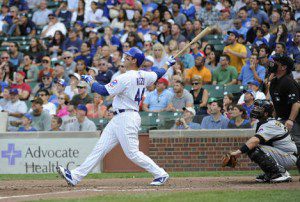
The Chicago Cubs and the Atlanta Braves are the only two franchises that can trace their history all the way back to the founding of the National League in 1876. In that sense, the Cubs have played major league baseball for as long as anybody, and longer than most. And yet, in all that long history, their worst day on the diamond happened 37 years ago. And it was the day that changed my life forever.
The Cubs sent Rick Reuschel to the mound on that day to face the Pirates’ John Candelaria. The Pirates teed off of Reuschel in the first, and kept the onslaught going against Tom Dettore in relief. By the end of the first half inning, the Pirates had a 9-0 lead. The paid crowd of 4,932 fans had probably already begun thinning out by then. And no, the attendance figure is not a typo. Crowds in the low four digits were common at Wrigley Field in 1975, including a low of just 1,427 for a game against the Montreal Expos on the final Friday of the regular season that year.
The Cubs didn’t answer offensively, and the rest of the game turned into an epic rout. After the Pirates batted around in the fifth, their lead stood at 18-0 after four and a half innings of play. The vendors and ushers in the stands may have outnumbered the fans by that point. But the game was still only half over.
The Pirates scored two more in the sixth, and two more in the seventh, to push their lead to 22-0. It was, and would remain, the largest shutout margin of the entire 20th century, and has been equaled just once since then, when the Indians beat the Yankees by the same score in 2004.
But about that time, there was a seven year-old kid down in the heart of Cardinals country who was turning on the TV. He had come home from school that day and, because he was nursing a broken leg suffered in a game of hide-and-seek (long story), was unable to go outside like he wanted to. He turned the channels and came to a local CBS affiliate that carried Cubs games on a feed from WGN-TV in Chicago.
The first thing this young boy saw was Rennie Stennett of the Pirates pulling into third base with a triple. The announcer said that it was the first time a ballplayer had collected seven hits in a nine-inning baseball game. A graphic flashed on the screen, stating that Stennett was now 7-for-7 in the game.
The young boy with a broken leg, who had gone to his first baseball game in St. Louis at the end of June that year, was fascinated by this bit of baseball trivia. He began watching the game, noticing the funky ballpark that was so much different from that one in St. Louis. He didn’t yet know that 22-0 was an unusual baseball score. All he knew was that it was baseball, and it was on TV, and that was just fine with him.
The young boy began watching more baseball games with the team from Chicago. He liked the announcer for the team, a grandfatherly gent named Jack Brickhouse. Whenever the Cubs lost, Jack would recap the game, but whenever the Cubs won, he would recap the thriller. He clearly loved the game, and the team, and his passion for them rubbed off on me, too.
Sunday’s Cubs game against the Pirates marked the first time Pittsburgh had played in Wrigley Field on September 16 since that fateful day 37 years ago. The Cubs held the Pirates scoreless in the first and then scored a run themselves, as if to serve notice that the 1975 disaster would not repeat itself this time. The Cubs went on to win the game 13-9, behind two home runs from Anthony Rizzo and Alfonso Soriano‘s 100th RBI of the season.
Do any of today’s players have an inkling of what happened in Wrigley Field on September 16, 1975? No, I’m sure that they don’t. Likewise, many Cubs fans either weren’t yet alive on that day, or have blocked out the memory of the game altogether. But since it marks my birthday, at least in the sense of becoming a Cubs fan, I wanted to write this out and explain the day’s significance to anyone who might want to know about it. Somebody should do it, at least.
